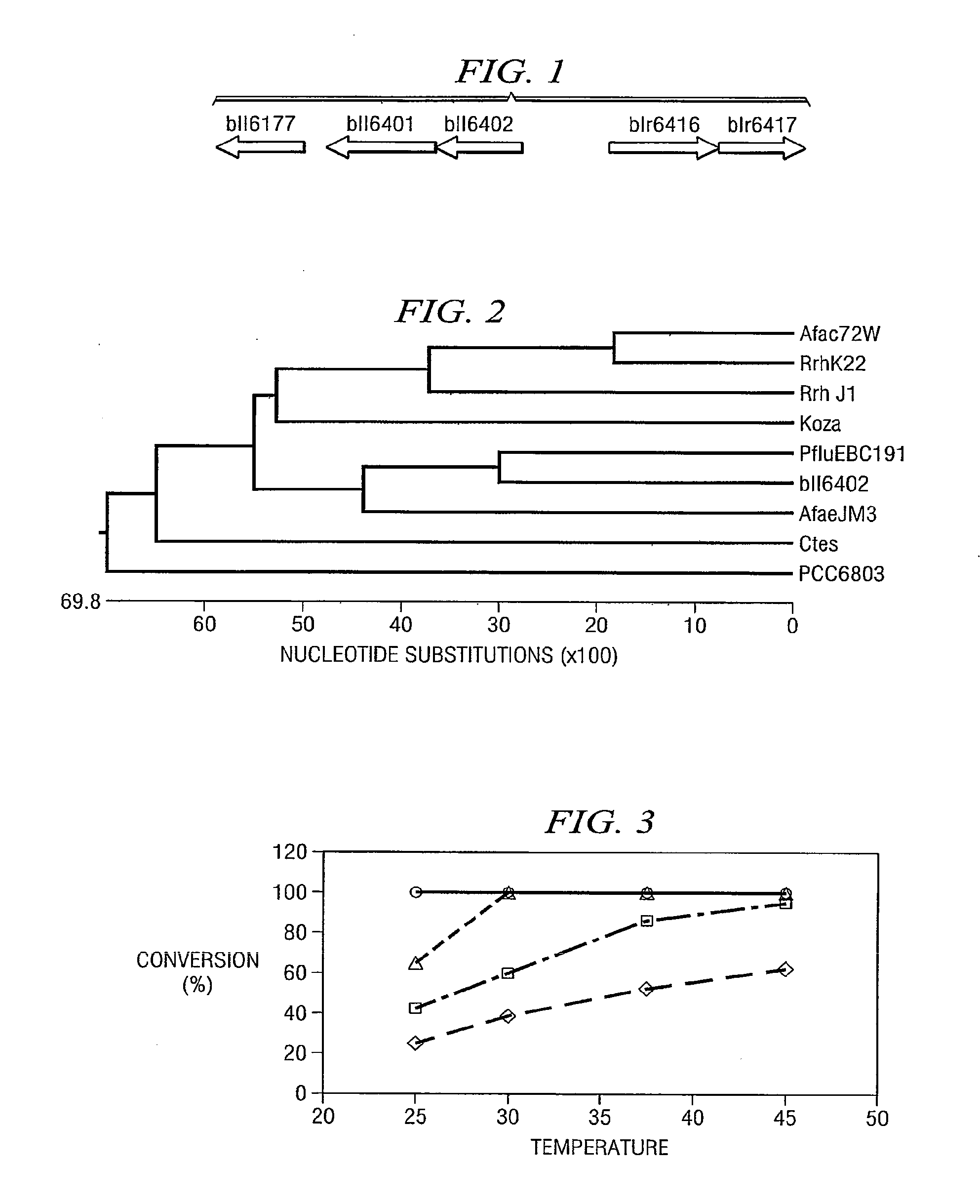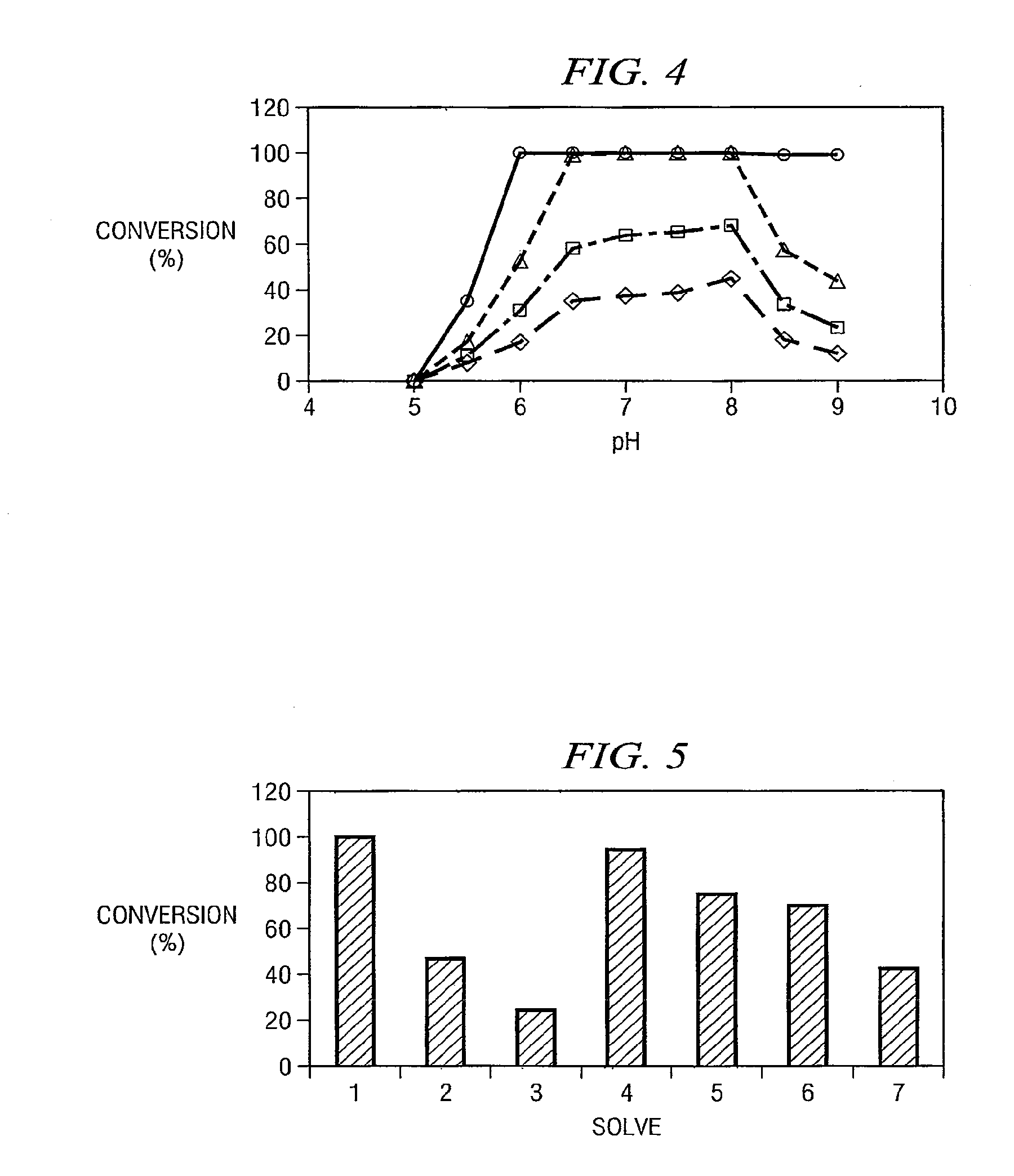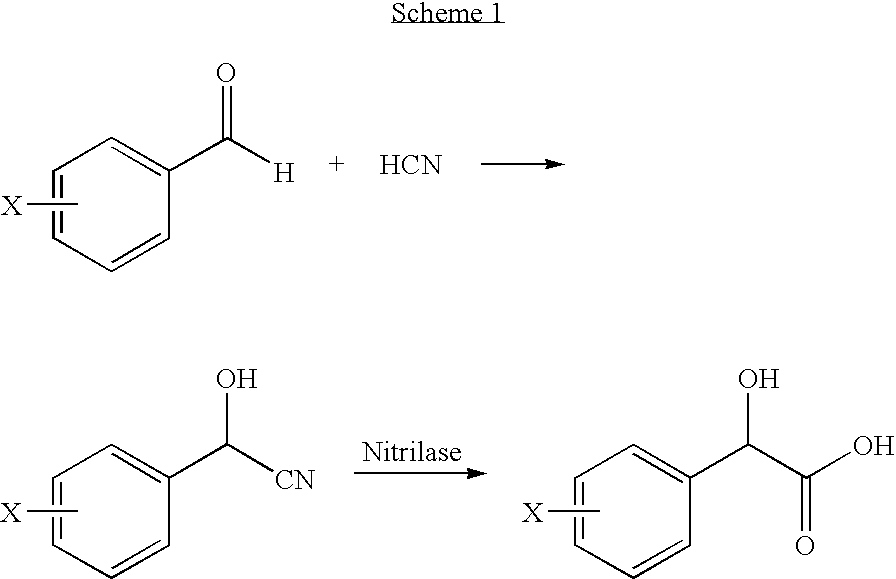Identification of a nitrilase from b. japonicum by rational genome mining and methods of use
a nitrilase and genome technology, applied in the field of nitrilases, can solve the problems of critical bottleneck in the discovery of enzyme catalysts, and achieve the effect of broad working ph range and increased reaction ra
- Summary
- Abstract
- Description
- Claims
- Application Information
AI Technical Summary
Benefits of technology
Problems solved by technology
Method used
Image
Examples
example 1
Identification of a Putative Nitrilase Gene bll6402) by Rational Genome Mining
[0048]An in silico screening of DNA sequence a database for putative nitrilase genes in microorganisms was performed. A query using “nitrilase” as an identifier was submitted to Entrez Gene database and 98 hits were obtained (as of March 2005). Since bacteria were known to be responsible for the degradation of many nitrile compounds, non-bacterial hits were excluded reducing the number of hits to 51. Among them, 49 ORFs (open reading frames) were annotated as possibly encoding proteins containing a carbon-nitrogen hydrolase domain, which might belong to nitrilase superfamily. The two that did not contain a carbon-nitrogen hydrolase domain were excluded. Since almost all of the known nitrilases consist of from 300 to 385 amino acids, open reading frames predicted to encode proteins outside of this range were excluded. Sixteen ORFs encoding putative nitrilases were identified in 14 sequenced microbial genome...
example 2
Cloning and Expression of the Nitrilase Gene bll6402
[0050]The Bradyrhizobium japonicum USDA110 strain was obtained from a stock collection maintained by the United States Department of Agriculture's Soybean Genomics and Improvement Laboratory.
[0051]The bll6402 gene (nucleotide, SEQ ID NO: 1; amino acid, SEQ ID NO: 2) was amplified from Bradyrhizobium japonicum USDA110 genomic DNA by forward primer 5′-TCGCATATGCAGGACACGAAATTCAAAGTCG-3′ (the Nde I restriction site is underlined) (SEQ ID NO: 3) and reverse primer 5′-AAACTCGAGAGTCTCGGTGAAAGTGACC5-3′ (the Xho I restriction site is underlined) (SEQ ID NO: 4). The amplification was performed in a final volume of 100 μl, and the reaction mixtures contained 200 ng of genomic DNA, 50 μmol of each primer, 200 μM of dNTP, 1×PCR buffer, 1.25 U of Pfx DNA polymerase and 1 mM MgSO4. The PCR amplified DNA fragment was digested with NdeI and Xho I and the 1026 by insert was cloned into pET22b expression vector digested with the same restriction enzy...
example 3
Preparation of Cell Extract and Purification of the Enzyme
[0052]The cultures of E. coli Rosetta (DE3)pLysS were harvested by centrifugation. The cell pellet was resuspended in potassium phosphate lysis buffer (10 mM, pH 7.2, 1 mM DTT), and the cells were lysed by homogenizer. The cell-free extract was mixed with equal volume of 2×PEI solution (0.25% polyethyleneimine MW 40K-60K, 6% NaCl, 100 mM Borax, pH 7.4) to remove lipids. The PEI-treated supernatant was precipitated with 45% ammonium sulfate. The resulting precipitate was collected after centrifugation and dissolved in potassium phosphate buffer (10 mM, pH 7.2, 1 mM DTT). The lysate was dialysed by gel filtration into potassium phosphate buffer (10 mM, pH 7.2, 1 mM DTT), and then used for activity assay.
PUM
| Property | Measurement | Unit |
|---|---|---|
| temperature | aaaaa | aaaaa |
| pH | aaaaa | aaaaa |
| temperature | aaaaa | aaaaa |
Abstract
Description
Claims
Application Information
 Login to View More
Login to View More - R&D
- Intellectual Property
- Life Sciences
- Materials
- Tech Scout
- Unparalleled Data Quality
- Higher Quality Content
- 60% Fewer Hallucinations
Browse by: Latest US Patents, China's latest patents, Technical Efficacy Thesaurus, Application Domain, Technology Topic, Popular Technical Reports.
© 2025 PatSnap. All rights reserved.Legal|Privacy policy|Modern Slavery Act Transparency Statement|Sitemap|About US| Contact US: help@patsnap.com



